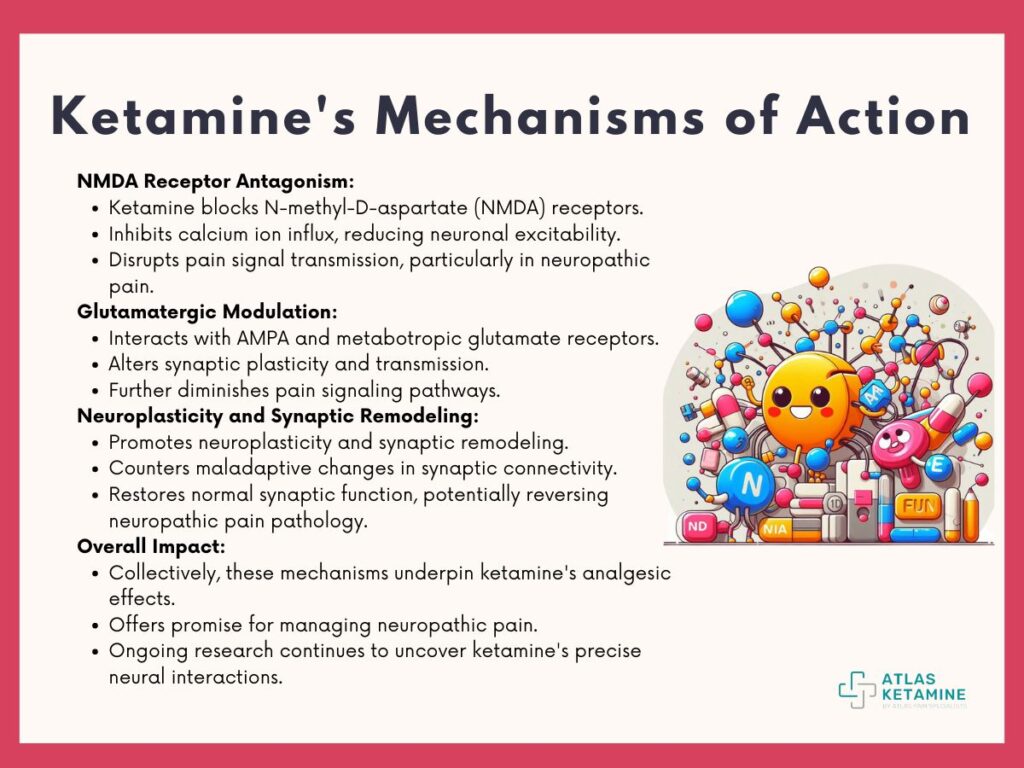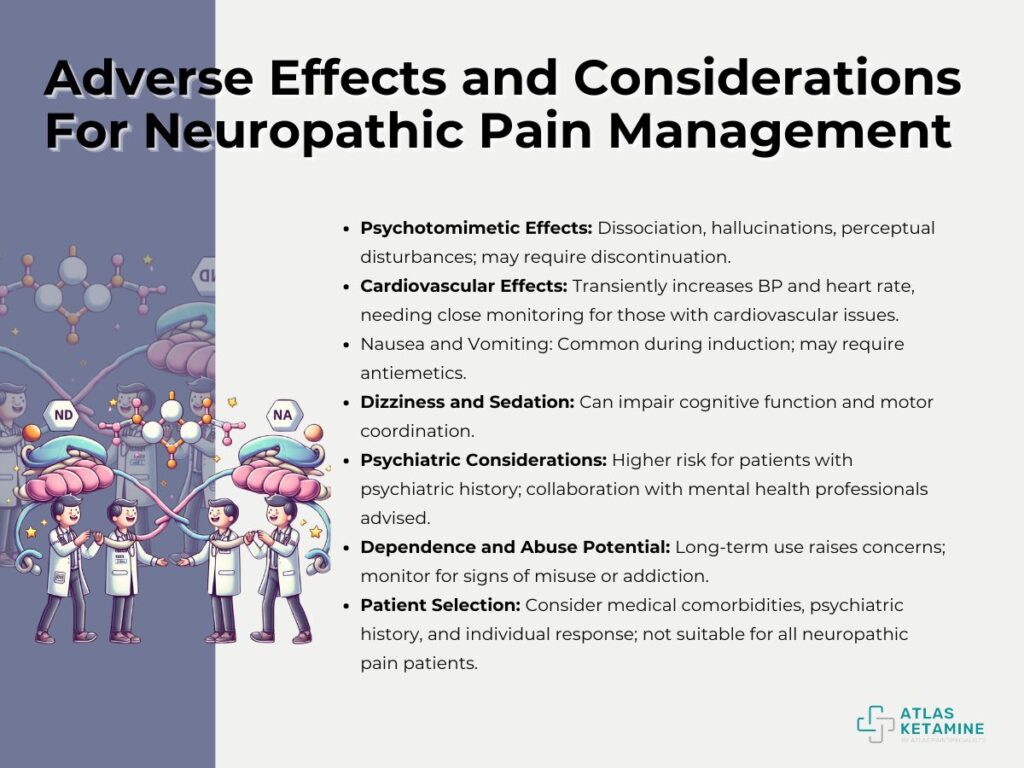Neuropathic pain, a complex and debilitating condition, arises from damage or dysfunction in the nervous system. Traditional pain management approaches often fall short in addressing the multifaceted nature of neuropathic pain. However, in recent years, ketamine, primarily known as an anesthetic and recreational drug, has emerged as a promising treatment option. Its unique pharmacological properties make it a valuable tool in the management of neuropathic pain.
Let's look at ways of managing neuropathic pain with Ketamine. This article delves into the mechanisms of neuropathic pain, explores the pharmacological actions of ketamine, discusses its role in neuropathic pain management, and examines the current evidence supporting its use.
Understanding Neuropathic Pain
Neuropathic pain, stemming from nervous system dysfunction or damage, manifests as spontaneous pain, heightened sensitivity to non-painful stimuli (allodynia), and an increased response to painful stimuli (hyperalgesia). Its origins vary, including nerve injury, inflammation, infections, or systemic diseases like diabetes or multiple sclerosis. Despite diverse causes, neuropathic pain shares maladaptive changes in the nervous system, such as altered neuronal excitability and neurotransmitter function.
Diagnosis hinges on a thorough assessment encompassing patient history, physical examination, and diagnostic tests like nerve conduction studies. Management typically involves a multifaceted approach targeting both symptoms and underlying mechanisms. Traditional analgesics like NSAIDs and opioids may offer relief but come with risks. Medications directly affecting the nervous system, such as antidepressants and anticonvulsants, are often preferred.
Emerging treatments like neuromodulation techniques and pharmacological agents such as ketamine provide promising alternatives. However, ongoing research into neuropathic pain's mechanisms and therapeutic approaches remains critical to enhance outcomes and alleviate its substantial impact on patients' lives.
The Role of Ketamine in Neuropathic Pain Management
Ketamine, originally recognized for its dissociative anesthetic properties, has garnered attention for its diverse pharmacological effects, particularly in pain management. As an N-methyl-D-aspartate (NMDA) receptor antagonist, ketamine's primary mode of action extends beyond anesthesia, encompassing potent analgesic properties. This multifaceted profile positions ketamine as an appealing option for alleviating neuropathic pain, a condition notoriously challenging to treat.
In contrast to traditional analgesics, which predominantly target opioid receptors or monoamine reuptake, ketamine operates on various levels within the intricate network of pain pathways. By inhibiting NMDA receptors, ketamine disrupts the transmission of pain signals, effectively dampening nociceptive processing.
Moreover, ketamine modulates glutamatergic transmission, altering synaptic plasticity and transmission efficiency, which further contributes to its analgesic effects. Additionally, ketamine attenuates central sensitization, a phenomenon associated with neuropathic pain, by modifying neuronal excitability and synaptic connectivity. This comprehensive modulation of pain pathways underscores ketamine's unique potential as a therapeutic agent for neuropathic pain management.
Ketamine's Mechanisms of Action
Ketamine exerts its effects through several distinct mechanisms:

NMDA Receptor Antagonism
Ketamine acts as a noncompetitive antagonist of N-methyl-D-aspartate (NMDA) receptors. By binding to these receptors and blocking their activation, ketamine inhibits the influx of calcium ions into neurons. This blockade reduces neuronal excitability and disrupts the transmission of pain signals, particularly those associated with neuropathic pain.
Glutamatergic Modulation
Beyond its action on NMDA receptors, ketamine modulates glutamatergic neurotransmission. It interacts with other glutamate receptor subtypes, including alpha-amino-3-hydroxy-5-methyl-4-isoxazolepropionic acid (AMPA) receptors and metabotropic glutamate receptors. Through these interactions, ketamine alters synaptic plasticity and transmission, further attenuating pain signaling pathways.
Neuroplasticity and Synaptic Remodeling
Ketamine has been shown to promote neuroplasticity and synaptic remodeling in the brain. Chronic pain conditions like neuropathic pain are associated with maladaptive changes in synaptic connectivity. Ketamine's ability to induce synaptic remodeling helps restore normal synaptic function, potentially reversing the pathological changes observed in neuropathic pain states.
These mechanisms collectively contribute to ketamine's analgesic effects, making it a promising option for the management of neuropathic pain. However, the precise interactions and downstream effects of ketamine within the nervous system are still being elucidated through ongoing research.
Clinical Evidence and Efficacy
Numerous clinical studies and meta-analyses support the efficacy of ketamine in neuropathic pain management. These studies have demonstrated significant reductions in pain scores, improvements in functional outcomes, and enhanced quality of life in patients with various neuropathic conditions, including diabetic neuropathy, postherpetic neuralgia, and complex regional pain syndrome (CRPS).
Ketamine's versatility allows for various administration routes, including intravenous infusion, intramuscular injection, transdermal patches, and oral formulations. Intravenous ketamine infusion, often administered as a series of treatments over days or weeks, is the most widely studied and effective approach for neuropathic pain management.
Adverse Effects and Considerations
When considering ketamine for neuropathic pain management, it's crucial to be mindful of potential adverse effects and important considerations:

Psychotomimetic Effects
Ketamine administration can lead to psychotomimetic effects, including dissociation, hallucinations, and perceptual disturbances. These effects can be unsettling for patients and may require careful management or discontinuation of treatment in some cases.
Cardiovascular Effects
Ketamine can transiently increase blood pressure and heart rate, particularly during infusion. Patients with cardiovascular issues or hypertension should be monitored closely during treatment to mitigate potential risks.
Nausea and Vomiting
Nausea and vomiting are common side effects of ketamine administration, particularly during the induction phase. Antiemetic medications may be necessary to manage these symptoms and improve patient comfort.
Dizziness and Sedation
Ketamine can cause dizziness and sedation, which may impair cognitive function and motor coordination. Patients should be advised to avoid activities requiring mental alertness, such as driving, until the effects of ketamine have subsided.
Psychiatric Considerations
Patients with a history of psychiatric disorders, such as psychosis or mood disorders, may be more susceptible to the psychotomimetic effects of ketamine. Close monitoring and collaboration with mental health professionals may be necessary in such cases.
Dependence and Abuse Potential
Long-term use of ketamine raises concerns about the development of dependence and potential for abuse. Clinicians should carefully assess patients for risk factors and monitor for signs of misuse or addiction during treatment.
Patient Selection
Ketamine therapy may not be suitable for all patients with neuropathic pain. Factors such as medical comorbidities, psychiatric history, and individual response to treatment should be considered when selecting patients for ketamine therapy.
Overall, while ketamine can be an effective option for managing neuropathic pain, careful consideration of potential adverse effects and patient-specific factors is essential to ensure safe and appropriate use. Close monitoring and interdisciplinary collaboration can help optimize outcomes and minimize risks for patients undergoing ketamine therapy.
Future Directions and Challenges
As the use of ketamine for neuropathic pain management continues to evolve, several future directions and challenges warrant consideration:
Refinement of Dosing Protocols
Optimizing ketamine dosing protocols remains a key area of focus. Determining the ideal dosage, infusion rate, and duration of treatment to achieve maximal analgesic effects while minimizing adverse effects is essential. Personalized dosing strategies based on individual patient factors and pain profiles may enhance treatment outcomes.
Long-Term Safety and Tolerability
Addressing concerns regarding the long-term safety and tolerability of ketamine therapy is paramount. Research into the potential risks of chronic ketamine use, including neurotoxicity, cognitive impairment, and urological complications, is needed to inform clinical practice and ensure the sustained benefits of treatment.
Mechanistic Understanding
Further elucidating the underlying mechanisms of ketamine's analgesic effects in neuropathic pain is essential for refining treatment approaches and identifying novel therapeutic targets. Investigating the interactions between ketamine and various neurotransmitter systems, neuroinflammatory pathways, and neuroplasticity mechanisms may uncover new avenues for intervention.
Combination Therapies
Exploring the potential synergistic effects of combining ketamine with other pharmacological agents or non-pharmacological interventions holds promise for enhancing treatment efficacy and addressing the multifactorial nature of neuropathic pain. Combinatorial approaches may offer complementary mechanisms of action, minimize adverse effects, and improve overall pain management outcomes.
Access and Affordability
Ensuring equitable access to ketamine therapy and addressing affordability concerns are critical considerations. Developing strategies to mitigate barriers related to cost, availability, and healthcare infrastructure will be essential to expanding access to ketamine treatment for patients with neuropathic pain, particularly in underserved populations.
Patient-Centered Outcomes Research
Incorporating patient-reported outcomes and quality-of-life measures into clinical trials and real-world studies can provide valuable insights into the impact of ketamine therapy on patients' daily functioning, well-being, and overall satisfaction with treatment. Engaging patients in shared decision-making and treatment planning will be integral to delivering personalized care and optimizing treatment outcomes.
Addressing these future directions and challenges will require collaborative efforts among researchers, clinicians, policymakers, and patient advocacy groups. By advancing our understanding of ketamine's role in neuropathic pain management and addressing key areas of concern, we can improve the quality of care and outcomes for individuals living with neuropathic pain.
Summary
This article provides a thorough exploration of ketamine's role in neuropathic pain management, covering its mechanisms, clinical evidence, adverse effects, and future directions. It discusses ketamine's modulation of pain pathways, its proven efficacy in reducing pain scores, and the importance of monitoring for adverse effects.
Looking ahead, the article addresses challenges such as refining dosing protocols and enhancing accessibility. Overall, ketamine shows promise as a valuable intervention in alleviating neuropathic pain, but ongoing research and optimization are essential for its effective use.
